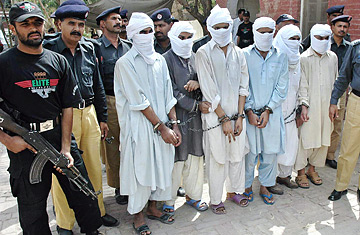
Pakistani police guard six members of the Sunni Muslim extremist group Lashkar_i_Jhangvi arrested in Multan, Pakistan in 2006.
(2 of 2)
It is not absolutely clear if or how Mehsud and Lashkar-i-Jhangvi link up. But both the Taliban and Lashkar-i-Jhangvi emerged from the two decades of fighting in Afghanistan, where eventually a Taliban regime would give refuge to al-Qaeda. Pakistani intelligence services were also active in Afghanistan, encouraging Muslim fighters in their war against the Soviet occupation of that country. One of the groups that emerged from this group was Lashkar-i-Tayyba or the "Army of the Pure," which Pakistani intelligence agents, after the end of the Afghan war, would redirect toward Kashmir and the Indian troops stationed in that disputed region. In January 2002, giving in to international pressure, the government of Pervez Musharraf finally kicked Lashkar-i-Tayyba out of Kashmir.
The group accused in Bhutto's killing, Lashkar-i-Jhangvi, was also among the alphabet soup of militant groups that were spawned by the Afghan war.One of the most vicious of these groups called itself Sipah-e-Sahaba and used religious justifications for jihad from an austere sect of Islam called Deobandi, similar to the ideology of the Taliban. Sipah-e-Sahaba and similar groups believe that one obligation of "true Muslims" is to kill so-called apostates like Shi'ites. In the early 1990s, these veterans from the Afghan wars, with no more war to fight, launched a bloody sectarian campaign against Pakistani Shi'ites. In 1996, amid these attacks, Lashkar-i-Jhangvi was formed by a disgruntled member of Sipah-e-Sahaba who named his group after the martyred founder of Sipah-e-Sahaba, Haq Nawaz Jhangvi. (Lashkar is an Urdu word meaning Army, hence "The Army of Jhangvi.") In January 1998, four Lashkar-i-Jhangvi gunmen fired AK-47 machine guns on a Shi'ite wake in Mominpura cemetery near Lahore, killing 24 mourners.
The group has close ties to al-Qaeda. The leadership of Lashkar-i-Jhangvi fought alongside many high-ranking al-Qaeda and Taliban operatives against the Northern Alliance in Afghanistan before Sept. 11, 2001. U.S. intelligence agencies believe many in its ranks trained in al-Qaeda-run camps in Afghanistan during the late 1990s. When al-Qaeda retreated from Afghanistan in 2002, many of its fighters are believed to have joined forces with Lashkar-i-Jhangvi and Lashkar-i-Tayyba, according to the State Department, which lists both groups as foreign terrorist organizations. Since then, the groups have targeted pro-Western entities of Pakistani society. In March 2002, Lashkar-i-Jhangvi retaliated against the U.S. invasion of Afghanistan and the resulting fall of the Taliban by launching a grenade attack on the International Protestant Church in Islamabad that killed 5 and injured dozens. In May, a car bombing outside a Karachi hotel killed 14, including 11 French defense technicians. Lashkar-i-Jhangvi is believed to have been behind it.
"It is probable there are links between Lashkar-i-Jhangvi and al-Qaeda," says Grare, "but it is certain they do have links to the government." He adds, "If the government itself says Lashkar-i-Jhangvi is involved, it is suicidal because it opens the door to speculation about their own role." Indeed, while Pakistani authorities have had a hand in encouraging groups like Lashkar-i-Jhangvi and Lashkar-i-Tayyba, Islamabad has done little to systematically dismantle these jihadist "armies" now that their original purposes — fighting the Soviets and supporting the Taliban in Afghanistan or fighting the Indians in Kashmir — are over. "They have nothing else to do," says Cohen, "and they are causing mischief." He adds: "It's like a cancer you've started elsewhere that comes back to eat you up."
